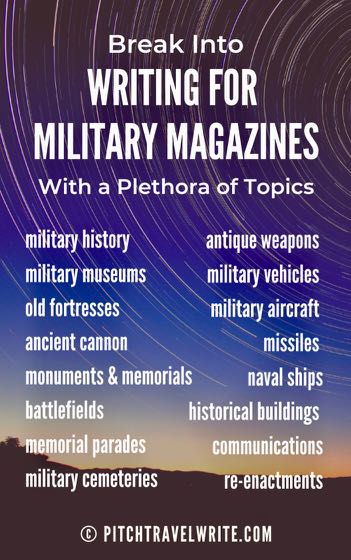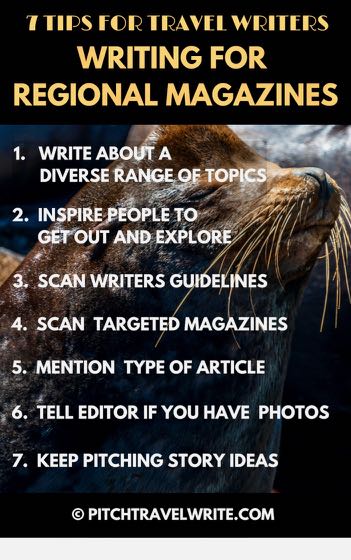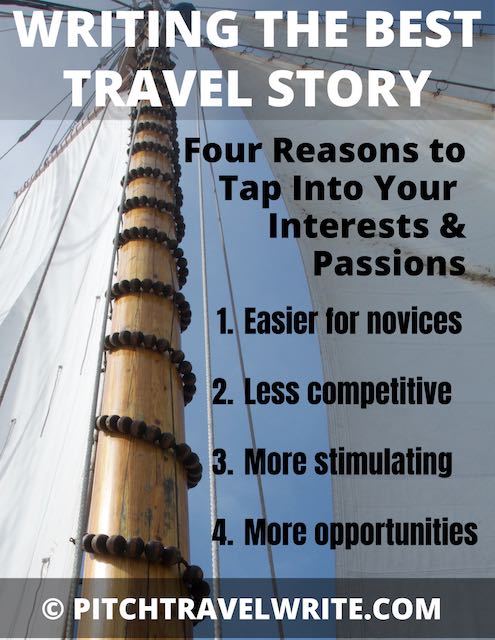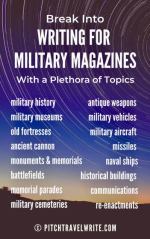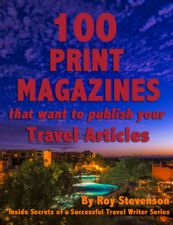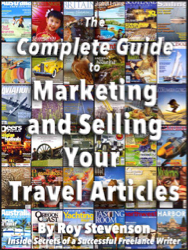- Home
- Types of Travel Stories
- Writing for Military Magazines
Writing for Military Magazines
A Popular Niche for Military Enthusiasts
By Roy Stevenson
My first few articles published in October 2007 were in military magazines. Since then I’ve had over 139 military stories published. They've appeared in more than twenty magazines and newspapers in the U.S., U.K, and New Zealand.
So far, every military story I’ve pitched has been picked up. I’ve resold many of them, often in other countries. This success has led to a regular military museum column for Military Magazine, which has further enhanced my credibility in this genre. Some of these articles have been 4-figure payouts.
Why this great demand for military articles? There’s always been a consistent need for military stories, but movies like Saving Private Ryan, Band of Brothers, Flags of our Fathers and other popular movies caused a resurgence of interest that shows no sign of abating.
You’d be amazed at how large and varied the military literature field is and how many military magazines there are out there. I have a staggering 87 military magazines on my pitch list!
You’ll also be surprised at how many non-military magazines will take military stories. I’ve had military themed articles appear in nationally and internationally distributed magazines and newspapers like Popular Communications, Monitoring Times, Renaissance, Scotland, SpaceFlight, Aviation History, VHF Communications, and New Zealand Sunday News. And history magazines will always consider your military stories because they’re a steady seller.
How to Break Into Writing for Military Magazines
I broke into military writing after visiting over two hundred European military museums, battlefields, memorials and military cemeteries while living in Brussels. I had lots of good content and photos. Wanting to share these experiences with other people, I was pleasantly surprised at how receptive editors were to these stories when I pitched them. Then, once the bylines started building up, my confidence grew and some of the higher echelon magazines started showing interest in my work.
I’ve had tremendous success pitching stories about military museums to magazines and newspapers. Museums are great topics to start your military writing career. There are hundreds of military museums spread out around the U.S.and in Europe.
And it’s not just U.S. publications that are interested in stories about U.S. military museums. I’ve sold stories about two U.S. military museums to a U.K. military vehicle magazine within the last few months and been paid well for them. I’ve also sold stories about U.K. military museums to U.S. magazines.
Have you visited any old fortresses with lots of ancient cannon lying around? I got started writing about these places. The Artilleryman magazine loves these stories and they haven't turned down any of my pitches about artillery museums and fortresses.
Here are some of my stories they’ve published, all good examples of combining travel and militaria:
- Artillery museums in Portsmouth
- Artillery at the Battle of Waterloo
- The Military Museum at Montjuic Castle in Barcelona
- The Gun Batteries and Military Museums at Edinburgh Castle
- The Sveaborg Fortress in Helsinki Harbor
- The Royal Gunpowder Museum in England
- The Artillery Museum at Spandau Castle
- Cannon at the Royal Museum of Military History in Brussels
- Artillery at Fort Nelson Royal Armoury
The Artilleryman does not pay much ($75), but it’s a great way to get your first byline and gain some confidence writing about military topics. And if you put some thought into your topics, you can select them with resale in mind.
I’ve resold my stories about Edinburgh Castle, and Artillery at the Battle of Waterloo, to U.K. magazines, making over $900 from those two pieces. And I’ve resold some of my other military articles to travel magazines.
When I travel to Europe, I stay for at least 3-4 weeks and schedule several military museums, fortresses and battlefields into my itinerary. I always come back with enough material to submit at least 6 military articles to magazines, significantly defraying my travel costs.
In addition, because I pre-sell the stories before my trip, I'm able to arrange free entry into these sites.
Think Outside the Box for Story Ideas
When most writers dream up topics to pitch, it’s usually famous battles that come to mind. But don't limit yourself. There is a plethora of other military-related topics that interest many editors.
There are plenty of military magazine markets available for most military stories. But to find them you need to think outside the box.
What I love, above all else, is that I can combine my love of travel writing with my passion for military places and artifacts.
For example:
- A story about the military vehicles at the Luxembourg National Military Museum is also a travel story.
- A piece about the gun batteries and military museums at Edinburgh Castle is also a travel piece.
- When you write about military fortresses, battlefields, monuments and memorials, memorial parades, cemeteries, vehicles, and historical buildings there’s also a travel element in them all.
For your own success and enjoyment when writing for military magazines, you should consider writing on aspects of militaria that interest you.
Here are a few topics to get you started:
|
military history |
antique weapons |
You can even find ideas on military topics in your own neighborhood.
Do you live near a famous historical battlefield? Look for a new slant on it. Have they uncovered something new (artifacts) at the site? Is there an annual battle re-enactment nearby that you can write about?
Look through your regional travel and lifestyle magazines and newspapers. They’ll often take military oriented articles, especially about local military museums and parades. I’ve had military stories in Pacific Northwest regionals like South Sound, Kitsap Sun, Columbia Gorge Guide, and the Sunday Oregonian.
You Don’t Have to be a Military Expert
You might be thinking, “Don’t I have to be an expert on military history to write about it?”
The short answer is: “No, you don’t.” You have to be an enthusiast - but you don’t have to be a professional military historian to get published in military magazines.
There are military magazines that require an advanced level of knowledge, but you can pitch those magazines after you’ve built up your bylines to an impressive number, say more than 10 magazines. With a decent number of bylines in military magazines, the editor will definitely consider your pitch.
But how do you get started writing for military magazines without having in-depth background in the topic?
The way I got started was by having access to an expert. An expert can help you with research and give you some quotes. It could be a museum curator or a local military historian. You’ll meet these people on your travels.
Recruit experts to assist with military vehicle, aircraft, and ancient cannon identification. You’ll find they’re only too pleased to help. They’ll love the challenge of identifying the photos of vehicles or cannon you send them. And they’ll supply you with lots of juicy details that you can write into your stories.
I thank my experts in the bylines and by naming them in article quotes. When they’ve been especially helpful I’ve even sent them a Barnes & Noble gift voucher.
Do lots of reading on your military topic. You’ll find it fun learning about it, and you'll become more confident with each article as your knowledge grows.
Consider writing free articles for some military magazines when you’re starting out, if you find out they don’t pay. I began by writing several free articles about Airborne Museums in Western Europe for two U.S. Airborne Association magazines called Airborne Quarterly and Static Line. For a couple years I wrote a free monthly military museum column that appeared alongside Colonel Oliver North’s column in Military magazine. While it didn’t pay, it certainly helped my credibility when pitching other military magazines.
Of course your aim should be to eventually place your free stories in paying magazines or newspapers. But having these bylines gives you the credibility and bylines to pitch other military magazines.
Finding Military Magazines
Where do you find magazines to pitch your military stories?
Having an interest in military vehicles is fertile ground. Try Classic Military Vehicles (U.K.) and Army Motors (U.S.).
Civil War enthusiasts can pitch Civil War News or any of the other half dozen U.S. magazines covering this era.
Antique weapons aficionados should try Arms & Armourer (U.K.) or any of the other antique weapons magazines.
And if you’ve visited military battlefield sites in Europe and the Pacific where American servicemen fought, you can pitch newspapers around the country several months before the anniversaries of those battles. August or September, for example, would be good months to send articles about the Battle of the Bulge, or Bastogne to newspapers, as those battles took place in December of 1944.
Here are nine other ideas in the military magazine market:
America in World War II
www.americainwwii.com
Interested in all aspects of WWII as it affected Americans.
Editor James P. Kushlan
, editor@americainwwii.com
American History
www.historynet.com
Roger L. Vance Editor,
Americanhistory@weiderhistorygroup.com
Army Motors
www.mvpa.org
For U.S. military vehicle aficionados.
Reg Hodgson Editor
armymotors@shaw.ca
The Artilleryman
www.civilwarnews.com
, focus on pre-1900 cannon and fortifications
mail@civilwarnews.com
Aviation History
www.Aviationhistory.org
Military and civilian aviation from first flight to jet age.
Carl von Wodtke Editor
aviationhistory@weiderhistory.com
Civil War News
www.civilwarnews.com
Editor:
mail@civilwarnews.com
Arms and Armourer U.K.
www.blazepublishing.co.uk
Battles, weaponry.
edit@blazepublishing.co.uk
History Channel Magazine
www.thehistorychannelclub.com, submit article to: The History Channel, Club,
Attn: Jim Tarbox, Editor, PO Box 3485, Minnetonka, MN 55343
Vietnam
www.historynet.com/magazines/vietnam
All aspects of the Vietnam War.
David T. Zabecki Editor
Vietnam@weiderhistorygroup.com
Break into Travel Writing
with the Creative Pack
The Creative Pack includes 3 eBooks that are the starting point for every travel writer: dreaming up unique story ideas that you can sell, finding the best writing niches for you based on your interests, passions and experience, and the art & craft of travel writing. They’re the pieces of the puzzle that come before you ever write a query letter to sell your articles to magazine editors.
If you're just getting started in travel writing, this group of resources will help you improve your craft, generate story ideas that sell, and develop your own unique and meaningful niche.
These eBooks can be purchased separately, but when you buy the bundle you'll save more than 10% off individual prices! Learn more here ...
More related topics that will interest you:
Writing Historical Travel Articles - and Getting Paid for Them
Travel Stories to Help You Find Your Niche

Roy Stevenson is a professional travel writer and the author of www.PitchTravelWrite.com. Over the past ten years, he’s had more than 1000 articles published in 200 magazines, trade and specialty journals, in-flights, on-boards, blogs and websites and has traveled on assignment around the U.S. and to dozens of international destinations.
IF YOU ENJOYED THIS POST, GET UPDATES. IT'S FREE.
